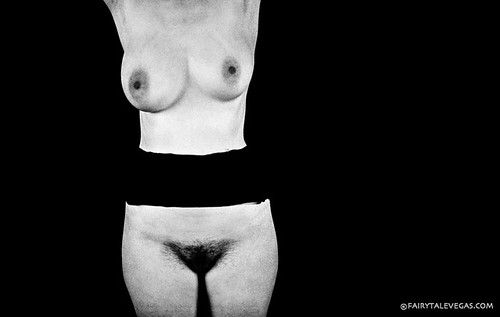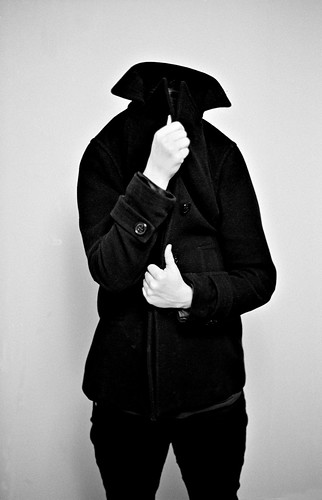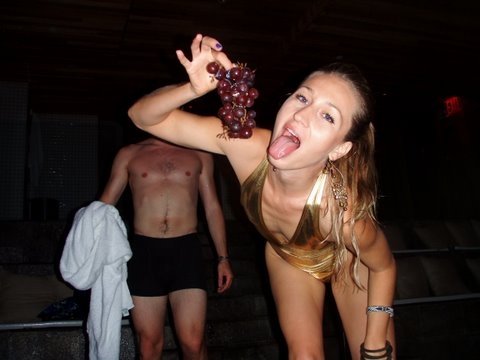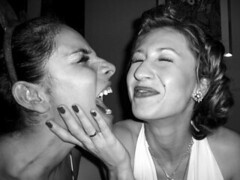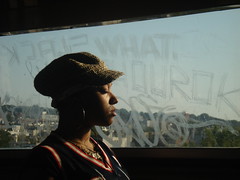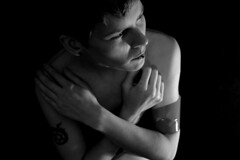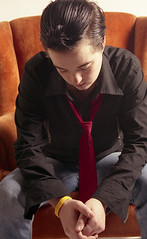A Girl Eyes GIRLEYE
A girl eyes GIRLEYE: WOMEN LOOKING AT WOMEN by Art Less (April 2010) All too often, looking at a collection of fine art “women regarding women” pieces is like inspecting a crèche of Tracy Enim clones. When you’ve seen the Enim originals, you know that this cannot be an easy sight to behold. Perhaps inspired by a collective misreading of Audre Lorde, certain feminist fine artists of the late twentieth century indulged a tendency to chuck out technique in its entirety, with the unfortunate, and predictable, result that many pivotal artworks of that movement come off rather worse in the looking than in the retelling. It is thus with great joy that I report that the photographs in Girleye: Women Looking at Women are by and large gorgeous, but also acutely conscious of sexual politics. (Fiiiiiinally!)
Instead of trouncing technique and tradition by, say, sculpting vulvas out of used car parts and calling them art when the spackle is dry, many of the artists of Girleye have instead chosen to (mis)appropriate the techniques and styles of their most misogynistic forebears for their own, empowered ends. In particular, the young, preternaturally skilled Lauren Goldberg channels the surrealist misogynist Man Ray through her photographs Disconnect and Distance.
That Ms Goldberg has even thought to rework Man Ray instead of, say, posing for him as a model would have constituted, from Man Ray’s or his contemporaries’ points of view, a radically feminist act. Isn’t progress grand?
Meanwhile, the sensitive and gifted Cassie Olander conjures Imogen Cunningham’s Triangles and similar carnal landscapes through her photograph "Unity".
Cunningham was, of course, a woman as well, so the homage initially seems uncomplicated. When the viewer, however, realizes that "Unity" teasingly, almost coyly depicts two nude women locked in a soft embrace, it becomes clear that Olander is repurposing Cunningham’s lauded and, by now, canonical means to send a still unconventional, perhaps radical message.
With LES, Anne Marie Hansen kills her father with rebellious joy and an almost mathematical elegance. The image is simple, powerfully so. A drunk girl in a tacky gold bathing suit dangles a bunch of grapes before her open mouth. The crook of her elbow suggestively obscures the head of a young man standing just behind her. The viewer’s gaze comes to rest on his not-yet-distended swim trunks.
With this image, Ms Hansen lays waste to Magritte, American Apparel ads, real pornography and countless other misogynistic portrayals of women reduced to their capacity as passive sex-recipients . . . by using their motifs and techniques to shoot a message of female sexual hunger straight down our hungry maws. (My father was quick to note that Hansen has reworked surrealist painting The Rape as The Grapes. Let the artist make of this what she may.)
Many other photographs in the set are simply beautiful portraiture. Amanda Palmer (making one of several cameos) has bad sunburn. A pair of nimble clowns practice what looks like acroyoga. Swimmers dot the surf like foam. Progress shows subtly, like light through a lattice. Slowly, we come to understand that it is the essence of the radical (and a slap in the face to both Laura Mulvey and the men whom she rightly criticized) for these photographers merely to portray their subjects with the variegation natural to two (or more) humans playing in the light, linked and loving through a camera lens, and nobody shunned or stopped or subjugated by the process at all. Most of all, that we cannot tell by any trick that these photographers were female is, upon (another) reflection, a most gorgeous happening.
Where, then, the rhymes and reasons to this set? There are many. We can start with the most unsubtle geometry exploited to great effect by the expert artists whose work is featured here—or perhaps, given the show’s very particular theme and patterning, by their curator. To put it bluntly: sexually evocative arcs and swoops and circles, punctuated, or punctured, by the occasional blunt or slender pole, abound in the collection. The vivid plethora of ovoid-and-spike figurings conjure an almost subliminal, spooky mentation reminiscent of Charles Burns’ Black Holes, which turned the vulva-shape into a repeated signifier of horror, a foreshadower of doom nested in appearances of the unexpected—such as a dissected frog’s back, a cut wrist, a lake where children skinny-dip. (Really, if you haven’t read a copy yet, you must—it’s the rare graphic novelist who can make the vulva into a Lovecraftian destroyer of worlds, and absolutely terrify you to pieces with it, and then make you cry.) I leave the viewer to pick his or her own incautious, revelatory path through the darkling bogs and brambles that litter the track of Girleye with a beauty, and a stillness, and danger.
Additionally, and flowing nicely from my bogs’n’brambles metaphor if I do write-so myself, bathing imagery pervades the show. Including the web-only images, roughly one sixth to one seventh of the pieces either allude to bathing or actually feature a nude lady bather or set of bathers. Factor in the joyous lesbian kissing, lesbian sex, and—let’s face it, people—lesbian hairstyles on display in several of the other photographs, and the images of happy women cavorting in water take on a rawer, sexier connotation.
In fact, the show seems to posit the old Radicalesbian message that one of the most authentic ways for women to relate to one another happily as women is by the art of sexual love. In Anne-Marie Hansen’s "Naughty",
a seemingly drunken reveler tilts a frenemy’s chin toward hers in a parody of sexual love, a parody that conceals revulsion. Immediately, for your own psychological wellbeing if for no other cause, contrast this deeply discomfiting (though beautifully done) image with Beth Hommel’s soothing Kiss,
a gentle expression of adoration between women who are real lovers, at least for the moment the camera saw.
Speaking of sex, or politics, or merely the bonds imposed, displaced, ignored or adored by the act of looking: a teasing kind of bondage pervades the images of Girleye. Cassie Olander wraps one subject in a dress of loose bondage tape marked “DANGER”, and another in what looks like a symbolic bracelet of packing tape about the upper arm. Allison Green wraps two nude females against one anther in a web of loose bondage tape that looks a bit like toilet paper or crepe streamers. One thing is clear—these bonds aren’t holding anybody anywhere. Are they jokes, suggestions, denials, teases? On or of the viewer, always—the bondage never holds the subject, in these photos. Greene also photographs two straight lovers turned away from each other in a scarlet bed, a strip of pure white tape pasted across their snuggly bods. The photographer seems to suggest that the bonds—of love, sex, of matrimony, for all we know—that hold these lovers together are as flimsy as the tape she has strewn atop them. (A commentary on the “sanctity” of marriage? Or just of young lusts?)
One rather wishes that curator Janet Bruesselbach’s work had been featured in this show. Indeed, the images seem to have been selected so that, en masse, they resemble one of her massive artworks. With her physics-defying, anatomically incorrect oil orgies and other acts of sly painterly nihilism, Bruesselbach has assembled a career out of teasingly cinching and severing the ties of artist to subject, subject to viewer, male to female, armpit to elbow and whatever else you can think of, always with an eye to disassembling old theory and provoking transformation. The child of two eccentric physicists forever rusticating in one of the more precarious reaches of the rarefied Malibu wasteland, Bruesselbach understands difference with anything but difference, and from more angles than even her most multiply valenced works could invite you, dear Reader, to contemplate.
So it is surprising and perhaps offensive, with all the above dimensions of diversity in mind from both curator and photographers, that all the subjects of Girleye (minus one) are white. One doubts that the artists of Girleye have conspired to constrict the scope of femininity to a single, whitewashed point. Rather, the show evidences by strong implication that the photographers simply don’t hang out with many people who aren’t white. Even Hommel’s Mail Order, a seeming send-up of (Third World, usually nonwhite) mail-order brides, features a white subject as the mailed party. The only actual nonwhite subject in the entire set appears to be a stranger to the photographer (Hansen in this case). Most other subjects meet Ms Hansen’s gaze with ease, evincing familiarity if not friendship. Her lips parted slightly, this subject gazes straight ahead, meditating to the music on her iPod as she wills the subway ride to be over. She appears to be a stranger whom Hansen happened to snap on a long train ride. The image is remarkable for its ordinariness, its emotional opacity. Hansen never knew her subject’s story and, therefore, we viewers will never know it, either.
Another note on difference: one wonders if artist Cassie Olander’s male-presenting subjects Liz and David (and I mean to mark the subject named David especially) would especially desire their images used in a collection of women who are nominally looking at women. The above are also two of the only brooding subjects in the entire show, and their haunted eyes shy from the camera’s shutter, leaving us only with the impression of hunched shoulders and obsessively pomaded hair. Hardly a representative image of butch or—more appropriately—trans moodiness, unless these two just started on their testosterone regimen, in which case, of course, all bets are off (just kidding!). I for one am willing to believe that Ms. Olander accurately captured sad moments in the lives of these two subjects, and from Olander’s other, also beautifully felt work must believe that Olander selected these moments, not to portray transmen as a sad breed generally but to show us the sadness of the falling cherry blossoms, as they happened to fall.
Maybe David and (probably) Liz are not transmen in the first place, but playful young women who happened to butch it up for their respective shoots. Maybe, maybe. But maybe not. What if they are transgendered? What if they really aren’t women? What if they hate the very idea of being included in this show? Well, have I got an interpretation for you.
Noted drag warrior and gender obscurist James St James writes wisely in his novel Freak Show (if you will allow me, dear Reader, to extend and wriggle a bit in this authorial stretch) that the transfolk of our society are trammeled and trashed by the violent misapprehensions of our culture, but the very chains (of thorns or flowers, of iron or of gold) that yoke transfolk into endocultural conflict enable them to act as revolutionary agents, and aching reminders of the impermanence of “fates”.
If this were a slightly academic article and not a (bl)o(g)nanism, I’d write some lameass transition phrase like:
If my interpretation of St James is to be believed, we may celebrate Girleye’s inclusion of transmen—not for the men’s futures qua men, but for the intersection of their futures with their girlish pasts. Or, to misappropriate the oft-appearing Amanda Fucking Palmer, girls will be girls will be boys with no warning. Such transitions imply a potential for our own . . . into boys, into women, into whatever the hell we want, be it sexes or genders or any of the manifold wondrous identities that lie not between our legs but in our lives.
Trans is Latin for across, after all. It would be great if transmen, biowomen, and everyone in between could appreciate the plenitude of identities open to them throughout their lives. And that’s just what this show is for. Let us embrace David, Liz, and all the rest with open arms and mouths and water-forms, and hope that perhaps they like us, too, just a bit at least . . .
On that note, let us close by oh so gleefully misusing a monster quote from that master of misuse, and of potential-play, Donald Barthelme, masquerading here under the voice of a woman impregnated with a fetus by three men—in our interpretation, a woman who becomes us, impregnated with transformative potential by the girls of Girleye:
The engendering force was, perhaps, the fused glance of all of them. From the millions of units crawling about on the surface of the city, their wavering desirous eye selected me. The pupil enlarged to admit more light: more me. They began dancing little dances of suggestion and fear. These dances constitute an invitation of unmistakable import—an invitation which, if accepted, leads one down many muddy roads.
I accepted. What was the alternative?
9
